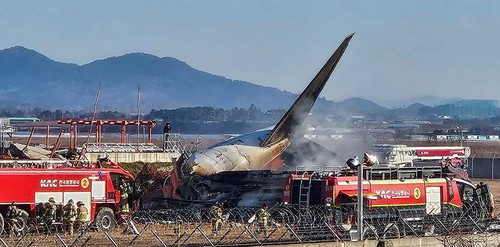
The greatest airline catastrophe in South Korea claims 179 lives in a fiery jet accident
At Muan International Airport on Sunday, an airplane belly-landed and went off the end of the runway, exploding in a blaze as it crashed into a wall, killing 179 people in the worst air catastrophe in South Korea’s history.
According to South Korea’s transport ministry, Jeju Air (089590.KS), which launched new tab flight 7C2216, was attempting to land at the southern airport just after 9 a.m. (0000 GMT) after coming from Bangkok, the capital of Thailand, with 175 passengers and six staff members on board.
Two crew members were being treated for their injuries after surviving.
According to the transport ministry, the worst air disaster to occur on South Korean land was also the worst to involve a South Korean airline in almost thirty years.
Video from the local media showed the twin-engine Boeing 737-800 drifting down the runway without any landing gear visible before exploding in flames and debris and colliding with a wall and navigation equipment.
At a news briefing, Muan fire chief Lee Jung-hyun stated, “Only the tail part retains a little bit of shape, and the rest of (the plane) looks almost impossible to recognize.”
According to Lee, the two crew members—a man and a woman—were pulled from the blazing plane’s tail area. According to the head of the local public health center, they were receiving treatment in hospitals for medium-to-severe injuries.
According to Lee, investigators are looking at weather and bird strikes as potential contributing reasons. According to airport officials quoted by Yonhap news agency, the landing gear may have malfunctioned as a result of such a blow.
According to data from the transportation ministry, the crash was the deadliest for any South Korean airline since a 1997 Korean Air disaster in Guam that claimed over 200 lives. An Air China catastrophe that claimed 129 lives in 2002 was the deadliest to ever occur on South Korean territory.
According to experts, there are more questions than answers about the bird strike incident and the aircraft’s landing attempt.
“There are now many more questions than there are answers. Why was the aircraft moving so quickly? What prevented the flaps from opening? “What prevented the landing gear from being down?” Gregory Alegi, a specialist in aviation and a former instructor at the Italian Air Force Academy, remarked.
The National Transportation Safety Board (NTSB) of the United States, where the aircraft was developed and constructed, will automatically be involved in the accident investigation, which will be led by South Korea in accordance with international aviation regulations.
Later, the NTSB said that it was heading a group of American investigators to assist the aviation regulator in South Korea. The Federal Aviation Administration and Boeing were also participating.
“MY LAST WORDS”
Red Cross volunteers distributed blankets as family members gathered in the airport’s arrival area hours after the tragedy, some sobbing and embracing.
According to police, a large number of casualties seemed to be locals returning from holiday.
As a doctor revealed the identities of the victims who had been recognized by their fingerprints, family members cried and yelled.
To get further information from authorities, one relative stood at a microphone. “My older brother died, and I don’t know what’s going on,” he stated.
Authorities claimed a makeshift morgue had been set up, and funeral cars lined up outside to remove the dead.
According to a representative of the transport ministry, the plane entered from the other direction after the pilots called mayday and tried to land shortly after the control tower gave a bird strike warning.
According to the News1 agency, a traveler contacted a family member to inform them that a bird had been lodged in the wing. “Should I say my last words?” was the last message sent by the individual.
A video of the collision was viewed and repeated by Jeon Je-young, 71, the father of one of the women on board.
“When I saw the accident video, the plane seemed out of control,” stated Jeon.
“It’s likely that the pilots were forced to do it. This is how my daughter, who is just in her mid-40s, ended up. He said, “This is unbelievable.” “She was almost home.”
One of the most frequently flown aircraft in the world with a generally good safety record is the Boeing 737-800, the kind that was involved in the incident. It was created long before the current Boeing safety incident with the MAX model.
According to the transport ministry, the aircraft was produced in 2009.
“We are in contact with Jeju Air regarding flight 2216 and stand ready to support them,” Boeing stated in an email statement. Our thoughts and prayers are with the passengers and crew, and we offer our sincere condolences to the families who lost loved ones.
According to the transport ministry, CFM International, a joint venture between GE Aerospace (GE.N), opens new tab and France’s Safran (SAF.PA), produced the two CFM56-7B26 engines.
“We are extremely saddened by the loss of Jeju Air flight 2216,” a CFM official stated. We offer the families and loved ones of those on board our deepest condolences.
The nation’s new interim president faces a challenge.
In a televised conference, Jeju Air CEO Kim E-bae expressed regret for the mishap and bowed sincerely.
According to him, the aircraft had no accident history and showed no early indications of failure. According to Kim, the airline would work with investigators and prioritize helping the grieving.
According to Kerati Kijmanawat, head of Airports of Thailand, there were no unusual circumstances when the plane took off from Suvarnabhumi Airport in Bangkok.
According to the transportation ministry, two Thai nationals were among the passengers, while the remaining individuals are thought to be South Koreans.
It was the first fatal flight for Jeju Air, a low-cost airline that was established in 2005 and is currently the third-largest carrier in the nation by passenger volume, after Korean Air Lines (003490.KS), opens new tab, and Asiana Airlines.
Just three weeks had passed since Jeju Air began operating frequent flights from Muan to Bangkok and other Asian destinations on December 8 when the disaster occurred.
Despite being one of the smaller airports in South Korea, Muan International has seen significant growth in recent years. Following the crash, Yonhap reported that all flights, both local and international, were canceled at the airport.
Arriving at the scene of the disaster, South Korean acting President Choi Sang-mok, who was appointed temporary leader of the nation on Friday in the midst of an ongoing political crisis, stated that the government was using every resource possible to address the tragedy.
According to Thai government spokeswoman Jirayu Houngsub, two Thai ladies, ages 22 and 45, were on the aircraft.
Both were later verified to have been among those slain by the Thai foreign ministry. According to a statement from the ministry, the embassy in Seoul was working with the South Koreans to make arrangements for family members to travel from Thailand.
In a post on X, Thai Prime Minister Paetongtarn Shinawatra expressed her sympathies to the relatives of the deceased and injured, stating that she has directed the foreign ministry to offer support.
All Categories
Recent Posts
Tags
+13162306000
zoneyetu@yahoo.com



